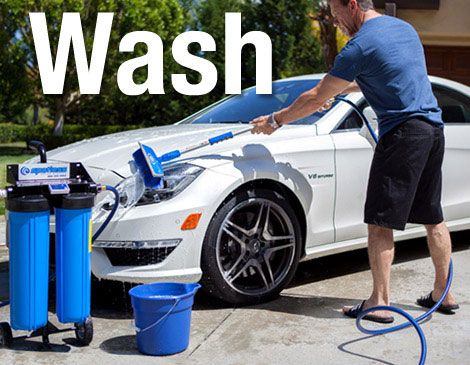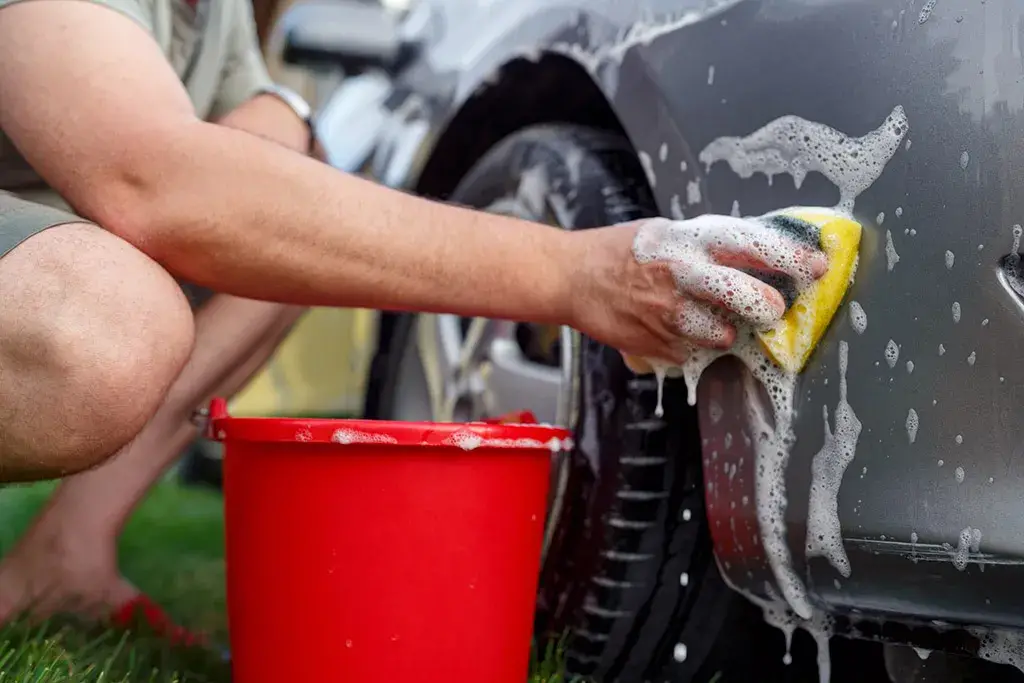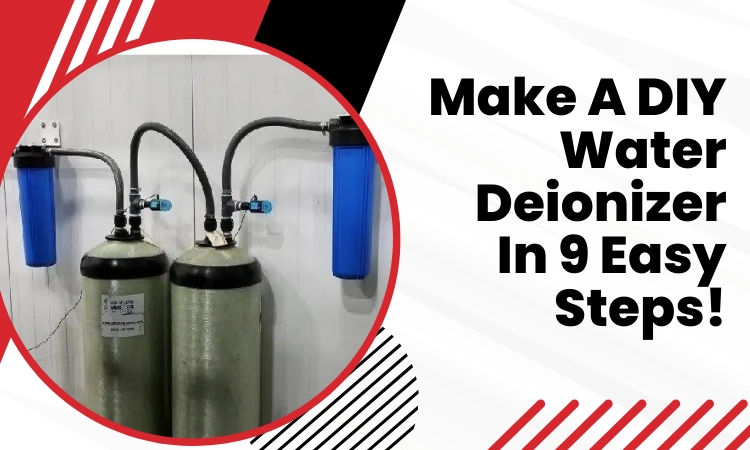Washing your car with tap water is awful. There are water marks left behind all over the windows, and cleaning them again just adds to the hassle.
Getting deionized water every time is pricey and an unnecessary cost. So, a DIY water deionizer would be the best possible solution.
But how to make a DIY water deionizer at home?
Water deionizers are very simple to make. You can make a water deionizer with two hoses, a water filtration vessel, resin, and some other plumbing accessories. Also, you will need a TDS meter to check if your water deionizer is really working. Although the process can be lengthy, it is beginner-friendly.
Let’s make a DIY water deionizer now that we have all the basics figured out!
Is Deionized Water Good For Washing Cars?

Yes, deionized water is good for washing cars. That is because it has all of its mineral contents removed and is the purest form of water, containing almost no minerals. That’s why it leaves no spot while washing cars and is the best choice.
Apart from this, it also offers additional benefits, which is why deionized waters are very popular in car washes.
Here are four reasons why you should be using deionized water for washing your car.
Reason 1: Leaves No Water Spots
Regular water can leave annoying water spots after drying when you wash your car because it is contaminated.
Deionized water does not have any minerals or contaminants. That’s why it leaves no marks when you use it to wash your car.
Leaves No Odor:
Regular tap water usually has an odor because of the chemical compounds or contaminants that are in it. So, if you use tap water to clean the insides of your car, it may leave a bad smell.
Using deionized water for cleaning the interiors would be a wise choice, considering it does not leave a smell. The reason is obvious; it is the purest form of water, containing no minerals.
So, you can save the cost of cleaning vomit in your car and do just as good a job, if not better.
More Efficient:
Using deionized water is a better option than using tap water for a car wash. Because of the deionization process, the water attracts more contaminants. That’s why it’s the easiest to clean with deionized water.
Not only that, but your car will also dry up quicker than tap water because it does not have any minerals. With deionized water, it’s not mandatory to use any chemical cleaners.
So, using deionized water saves time, energy, and money, making it the most efficient choice.
Must-Use for Waxing:
When waxing, you will need to use water with it, either before or during the waxing process. Deionized water is also the best choice here because it does not leave any spots.
Removing water spots is particularly hard after waxing, so it’s best to use deionized water.
To put it shortly, deionized water is the best type of water to use in your car’s exterior or interior. It doesn’t matter if you’re cleaning or wet sanding with soap.

How to Make a DIY Water Deionizer at Home
Now, let’s move on to the most important part, a simple step-by-step process of how you can make DIY water deionized at home. That too, with simple equipment that you can find in your local market.
Tools Needed:
- Two hose pipes, approximately three meters long
- An empty plastic bottle
- A water filtration resin vessel
- A large bag of resin
- Two hose lock ends
- Plumbers tapes
- Hose lock end connectors
- Two-hose lock knockoff
- A scissor
- A showerhead
Procedure:
Making a DIY water deionizer could be a lengthy process. So to simplify it, all procedures are divided into simple steps. Here they are,
- Use the scissor to cut a plastic bottle into the shape of a scoop. This will be used to scoop up the resin into the resin vessel.
- The resin vessel has a cap on top of it with a port on each side. Take it off and connect the hose connectors in each port with the plumber’s tape. The purpose of this is to ensure that they are watertight.
- Now, connect the hose lock end connectors to the hose connectors also using the plumber’s tape.
- Open the bag of resin and start filling the canister, roughly about 75-80% of it. Use the water bottle scoop here. You can insert the whole bottle inside the canister, that’s why it’s better to use a plastic bottle as a scoop.
- While filling up the canister, give it a little shake to let the resin spread evenly. This will fill the canister properly and leave no space.
- Put the top back on the canister. You might struggle a bit to fit the top as the canister is now almost full of resin. Still, carefully put the top back on the canister.
- Connect the two hose lock end knockoffs to the two hoses. Then connect the two hoses to each side of the canister top.
- You should notice the canister top has “IN” and “OUT” written on each side. Connect the water source to the side where “IN” is written.
- Connect a showerhead to the side where “OUT” is written.
Now, when you turn the water source on, the flow of the water from one end to the other will make it deionized. So, you should have deionized water on the other end.
How to Know Your Water Deionizer Is Working?
Now that you’ve made your DIY water deionizer, let’s see if it really works.
For this, you will need a TDS meter to test the water. First, take a bowl of water from the source and another bowl after the tap water has been filtered.
Then turn the TDS meter on. Make sure the meter reading is at zero.
Now, put the TDS meter in the source water bowl. Check the meter after holding it for a few seconds. The reading should be higher, probably around 300-400 or more. Do not worry about the value before filtration; it could be anything.
When you are done testing the source water, it’s time to test the filtered water. Submerge the TDS meter in it. The reading should be way lower than the source water, preferably zero or close to it.
If the filtered water has a value of less than 50, your water deionizer is working. If not, go through the whole DIY process again to see if you missed anything.
If not, then you have done it! Congratulations! Now you can wash your car with water without having to worry about water spots.

How to Use the DIY Water Deionizer
Hopefully, now you have your very own water deionizer. Before you use it regularly, here are a few tips on how to use it properly.
- Store it in a cool, dry place with the hoses disconnected.
- Always test the water with a TDS meter to check the water’s purity level. If the purity level keeps dropping, try to replace the resin. Using a TDS meter is very basic, so don’t worry about it.
- Always drain the remaining water after you are done using it. Do not store it with water inside.
- The larger the canister is, the more resin it can hold and the longer you can use it for purification.
- The water purification level would mainly depend on the quality of the resin. So, do get premium quality resin even if it costs a bit more.
- Make sure all the water hoses are watertight. Double-check them for any leakage.
Precautions to Take While Making a DIY Water Deionizer
The main component of the homemade water deionizer is resin. One of the downsides of resin is that it is toxic.
If the resins are swallowed or their fumes are breathed in, it could cause problems in your respiratory system. So, while handling resin, make sure to wear gloves and a mask.
Frequently Asked Questions (FAQs):
Is distilled water a good substitute for deionized water?
The answer to the question is that it depends on the intended use or application. Although both variations are forms of purified water, deionized water is more purified than distilled water. So, to get the best outcome, it is not recommended to use distilled water instead of deionized water.
Does boiling water make it deionized?
No, boiling water is not deionized water. However, boiling is a part of water distillation. Most of the impurities can be removed by boiling water, but it still does not deionize it.
What is a substitute for deionized water?
Deionized water can be substituted with distilled water in many cases, but it is not a suitable replacement for all purposes. While distilled water may be adequate for general use, it may not be suitable for scientific applications.
Can I use tap water instead of deionized water?
No, it would not be wise to use tap water instead of deionized water. Tap water can contain many impurities, whereas deionized water is the purest form of water. That’s why using tap water in place of deionized water would not be permissible.
Conclusion
As a car owner, you will need deionized water if you decide to wash your car yourself. So, having a DIY water deionizer at home can be useful.
The process is relatively simple but can take a while, so clear up your schedule. Also, use caution before handling resin. It’s also recommended to test the water before use to know for sure your water deionizer is working.
As an Amazon Associate I earn from qualifying purchases.



Where do I get the resin is there a specific name for the resin